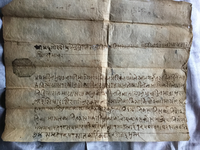A five-day ritual prescribed for residents of Pāro Gāũ to atone for the sin of contamination through sharing water with persons who have had illicit sexual contact with a members of a lower rank (VS 1951)
ID: Tsum_0001_0026
Edited and
translated by Nadine Plachta and Rajendra Shakya
in collaboration with
Rajan Khatiwoda
Created: 2018-03-11;
Last modified: 2020-01-22
For the metadata of the document, click here
The accompanying edition, translation/synopsis and/or commentary are available under the terms of the Creative Commons Attribution-ShareAlike 4.0 International License
Abstract
This is a ritual prescription for men and women of Pāro Gāũ to atone for having shared water with fellow caste members who have had illicit sexual relations with someone from a lower rank. The five-day process is meant to return the whole village to ritual purity.Diplomatic edition
[1r]
[Seal of the dharmādhikāra]1श्रीमद्गोरक्षेभुपेन्द्रप्रेरीतसमृतिसमृतिसमृतम् ।। ।। दुरीतक्षेदनोपायप्राय2श्चित्तसमाचर¯¯¯ ¯¯¯ ¯¯¯ ¯¯¯ ¯¯¯ ¯¯¯ ¯¯¯ ¯¯¯
3प्रथमदिनमुण्डनगरिमाटोभस्मलेपनगरिपंचगव्येलेस्नानगर्नुतसदिनदिनैमा
4हविष्येग्रास१२षानुदोश्रादिनग्रास१५षानुतेश्रादिननमागिकसैलेषाभ
5निदियारातृमाग्रास२४षानुचौथादिननिलाहारगर्नुपाचदिनमाव्राह्मण
6लाईसिधादक्षिणादिनुरकुसुल्यादमाञिकामिसार्किपोडेच्यामाषलक्
7हरुसगकरनिचुक्याकास्वास्निहरुकोरकुशल्यानिदम्यानिकम्यानिसरक्यानिपोड्या
8निच्यामाषलक्यानिहरुसगकरनिचुक्याकालोग्न्याहरुकोसामान्येपानिसंस
9र्गभयावापत्१८सयस्यारपट्टिपारोजील्ला१गाउलाई१९५०|५१|५२सालवर्ष३
10शुद्धसम्वत१९५१सालकार्तिकवदि९रोज३शुभ्म्¯¯¯ ¯¯¯ ¯¯¯ ¯¯¯ ¯¯¯
Translation
[1r]
[Seal of the dharmādhikāra]
By order of the venerable king of Gorkhā, make atonement (prāyaścitta) in accordance with the smṛtis as a remedy that removes evil.
[On] the first day: after shaving [your head] and anointing your body with [sacred] ash and clay, wash yourselves with the pañcagavya. On the same day, eat 12 morsels (grāsas)1 of sacrificial food (haviṣya). Eat 15 morsels on the second day. On the third day, during the night, eat 24 morsels if somebody offers [food] without your having asked [for any]. Abstain from taking food on the fourth day. On the fifth day, offer sidhā and dakṣiṇā to Brahmins, and [henceforth] the one village in the district of Pāro towards Syāra in 18 Saya [Kholā] [will be considered] purified (śuddha) 2 for three years, [namely] the years [VS] 1950/51/52 (1893/94/95 CE) in regard to contamination from being water with women who have had illicit sexual contact with a Kusle, Damāī, Kāmī, Sārkī, Poḍe [or] Cyāmakhalaka [man] or being shared with men who have had illicit sexual contact with a Kusle, Damāī, Kāmī, Sārkī, Poḍe [or] Cyāmakhalaka [woman].
Tuesday, the 9th of the dark fortnight of Kārtika of the [Vikrama] era year 1951 (1894 CE). Auspiciousness.
Commentary
This document prescribes a five-day purification ritual to purify residents of Pāro Gāũ from the sin of sharing water with fellow residents of the same rank who have had illicit sexual relations with a person from a lower rank. For the Buddhist residents of the village, the notion of following a ritual based on a Hindu caste hierarchy and the concept of untouchability was undoubtedly surprising. Few Hindus have lived in Tsum in the past or at present, but the society was highly stratified in its own terms, and there were impure groups. Even today, people considered impure are not allowed to share their glasses and plates with the rest of society, and there are purification rituals if this happens. These people are called rinang in the local dialect, only two families of whom are left in Tsum.
While there is no mention of the person or the office that issued the document, the seal of the dharmādhikāra gives reason to assume that it was issued by him. Similar documents are extant from other parts of Nepal. For example, a document in the personal collection of the dhāmī of Nuvākoṭa is almost identical in content, the ritual prescribed in it displyaing only slight variation (Vajrācārya and Śreṣṭha 2032: 93). Michaels provides a translation of another similar text (Michaels 2005: 41).

